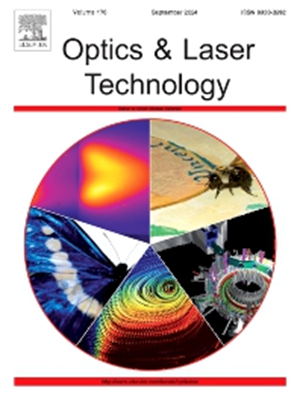Study on oscillating laser welding of 6061-T6 aluminum alloy medium-thick plate: Energy distribution, joint forming, texture evolution, and mechanical properties
IF 4.6
2区 物理与天体物理
Q1 OPTICS
引用次数: 0
Abstract
This study systematically investigates the implementation of beam oscillation into conventional laser welding of 6061-T6 aluminum alloy, with the objective of optimizing weld seam appearance, mitigating defects, and enhancing the mechanical properties of welded joints. Computational analyses reveal that frequency (f) and welding speed () exert a significant influence on the trajectory overlap rate (), while amplitude (A) exhibits negligible impact. The transient velocity () of the laser beam fluctuates within a defined range, modulating the transient linear energy density (P/). The essential effect of beam oscillation lies in its capacity to redistribute laser energy deposition on the processing surface. To quantitatively characterize this phenomenon, an energy distribution model (EDM) was developed, incorporating laser energy attenuation and beam superposition effects. A comprehensive experimental investigation was conducted to evaluate the influence of f, A, and on weld formation characteristics, cross-sectional geometry, texture evolution, and mechanical properties. Optical microscopy (OM) and X-ray detection analyses demonstrate that beam oscillation effectively suppresses defect formation, including collapse, undercutting, spatter, and internal porosity. Increasing f, A, or results in a reduction of fusion zone width and penetration depth due to decreased heat input, with penetration depth exhibiting greater sensitivity to these parameters compared to weld width. A distinctive “double molten pools” phenomenon is observed, arising from an energy distribution profile characterized by a “low center, high sides” configuration, where a significant energy difference between the center and sides facilitates this behavior. When ΔE is below 4.25 × 1011 J/m2, heat accumulation in the central region inhibits the formation of “double molten pools.” Conversely, ΔE exceeding 4.51 × 1011 J/m2 induces localized heat buildup on both sides, promoting the formation of the “double molten pools.” Microstructural characterization using OM and electron backscatter diffraction (EBSD) reveals that repeated thermal cycles induced by the oscillating beam promote grain coarsening in the heat-affected zone (HAZ). The multi-columnar dendritic structures on both sides of the weld exhibit varying lengths and primary dendrite arm spacing (PDAS) due to uneven heat input. The remelting zone microstructure displays a strong {001} < 100 > cube texture with pronounced anisotropy, which detrimentally affects mechanical properties. Both the HAZ and the remelting zones are identified as mechanically weak regions in oscillating laser-welded (OLWed) joints, exhibiting mixed fracture modes, including shear fracture, microvoid coalescence-induced ductile fracture, and intergranular brittle fracture. The microhardness profile of the OLWed joints exhibits significant fluctuations, with a gradual decrease in hardness as the measurement location approaches the remelting zone interface at the top of the weld. This study provides critical insights into the underlying mechanisms of beam oscillation in laser welding and its influence on weld quality and mechanical performance, establishing a foundation for further optimization of welding processes for 6061-T6 aluminum alloy. The findings contribute to advancing the understanding of energy redistribution and microstructural evolution in oscillating laser welding, offering potential applications in high-performance welding of aluminum alloys.
求助全文
约1分钟内获得全文
求助全文
来源期刊
CiteScore
8.50
自引率
10.00%
发文量
1060
审稿时长
3.4 months
期刊介绍:
Optics & Laser Technology aims to provide a vehicle for the publication of a broad range of high quality research and review papers in those fields of scientific and engineering research appertaining to the development and application of the technology of optics and lasers. Papers describing original work in these areas are submitted to rigorous refereeing prior to acceptance for publication.
The scope of Optics & Laser Technology encompasses, but is not restricted to, the following areas:
•development in all types of lasers
•developments in optoelectronic devices and photonics
•developments in new photonics and optical concepts
•developments in conventional optics, optical instruments and components
•techniques of optical metrology, including interferometry and optical fibre sensors
•LIDAR and other non-contact optical measurement techniques, including optical methods in heat and fluid flow
•applications of lasers to materials processing, optical NDT display (including holography) and optical communication
•research and development in the field of laser safety including studies of hazards resulting from the applications of lasers (laser safety, hazards of laser fume)
•developments in optical computing and optical information processing
•developments in new optical materials
•developments in new optical characterization methods and techniques
•developments in quantum optics
•developments in light assisted micro and nanofabrication methods and techniques
•developments in nanophotonics and biophotonics
•developments in imaging processing and systems

 求助内容:
求助内容: 应助结果提醒方式:
应助结果提醒方式:


